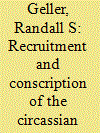| Srl | Item |
| 1 |
ID:
164917


|
|
|
|
|
| Summary/Abstract |
This article examines the virtually unexplored topic of the Baha'i religious minority in Israel's early statehood period based mainly on primary source documentation. It will be argued that while the number of Persian Baha'is in Israel after 1948 was minuscule — even smaller than the similarly minuscule Circassian and Armenian populations — the non-Arab and non-Muslim identity of the Baha'is, the lack of any historical antagonism between the Baha'is and the Jews, a shared history of marginalization in the modern Middle East, the Baha'is' principled commitment to non-violence as a basic tenet of their religious faith, their complete neutrality leading up to and including the 1948 War, (and their support for Jewish statehood after it), their lack of proselytizing in the state of Israel, and the fact that nearly all of their high-ranking administrators in post-independence Israel hailed from the United States — whose support Israel sought — led the state to cultivate this minority to a degree few other minorities experienced in post 1948 Israel.
|
|
|
|
|
|
|
|
|
|
|
|
|
|
|
|
| 2 |
ID:
114161


|
|
|
|
|
| Publication |
2012.
|
| Summary/Abstract |
This article examines the process leading to the draft of the Sunni Muslim Circassian community into the Israel Defence Forces beginning in 1958. While the Circassians were the second and final minority group to be drafted into the IDF (following the Druze in 1956), the background to and implementation of the draft of this community in Israel has been virtually ignored by previous researchers. This article is the first to examine the process leading to the Circassian draft based on original documentation, and argues that the small number of Circassians enabled the army to incorporate them without threatening the army's fundamentally Jewish character; it also enabled the state to demonstrate its commitment to democracy and equality by incorporating a (second) non-Jewish minority group into a central state institution. Additionally, Circassian service would theoretically engender divisions between Circassian and Arab Muslims, and finally - perhaps - would garner the sympathy of highly placed Circassians in the governments and armies of neighbouring Arab states.
|
|
|
|
|
|
|
|
|
|
|
|
|
|
|
|
| 3 |
ID:
151854


|
|
|
|
|
| Summary/Abstract |
Literature on the status of the Armenian population during the State of Israel's first decade is virtually nil; a scholarly investigation regarding why Armenians were not drafted into the Israel Defense Forces (IDF), when other small, non-Arab and/or non-Muslim minorities were, has not yet been written. While recognizing the paucity of available documentation, this article will seek to address both of these issues/questions in light of what sources are publicly available as well as in light of the author's own previous research into minority recruitment policies in post-independence Israel. This article will argue that while the Armenians appeared to fit nearly all of the IDF’s criteria for minority recruitment, an Armenian presence in the army ultimately would have provided few tangible advantages to the state from both a domestic and regional perspective. However, due to their non-Arab and non-Muslim identity, the Armenian population was treated as a ‘special minority’ and possessed certain unique privileges denied to other minorities in Israel. This was particularly noticeable in Haifa. However, in other ways, Armenians were treated by state authorities in a very similar manner to the far larger and more distrusted Arab population.
|
|
|
|
|
|
|
|
|
|
|
|
|
|
|
|